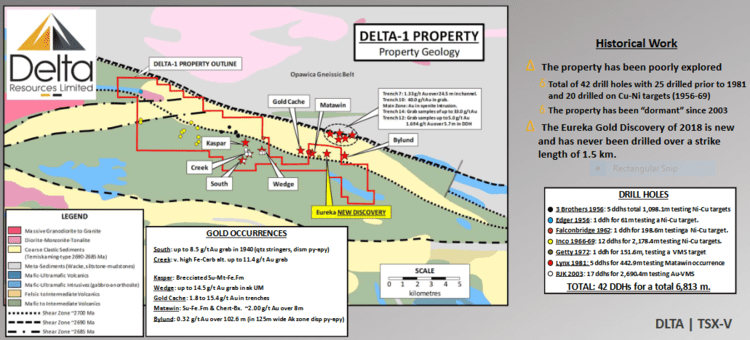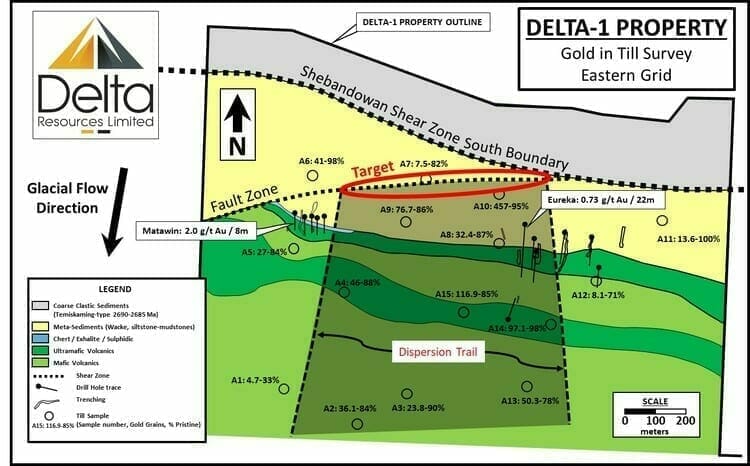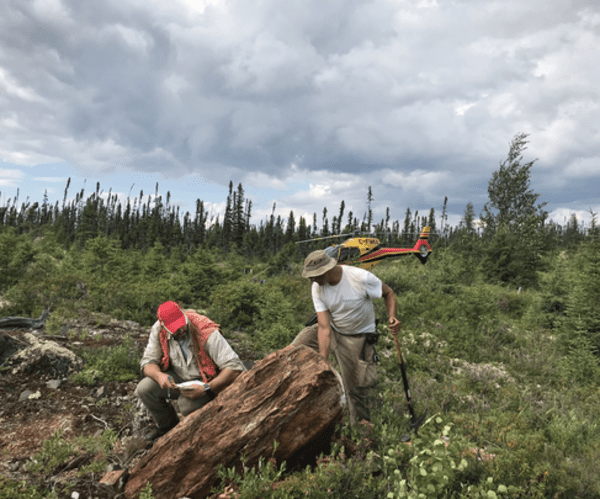Delta Resources (DLTA.V) is an ExplorerCo focused on its highly prospective Delta-1 (Eureka) project in the Thunder Bay area of Ontario and its Delta-2 project, located in the Chibougamau Mining Camp of Quebec.
Both projects are worthy of flagship status.
Both projects are being pushed further—aggressively—along the exploration curve.
Both projects may be on the cusp of finding a whole new gear.

Delta-2—a quick review

The 16,400-hectare road accessible Delta-2 project is located along the northeast end of the Abitibi Volcanic Belt, to the southeast of Chibougamau.
The Company is targeting two distinct types of deposits in the region—Volcanogenic Massive Sulphide (VMS) deposits like the past-producing Lemoine deposit (757 585 tonnes @ 9.52% Zn, 4.18% Cu, 4.56 g/t Au and 82.26 g/t Ag), and Magmatic-hydrothermal Au deposits like the Chevrier Zone (43-101 Resource of 10.8Mt @ 1.22 g/t Indicated and 6.3Mt @ 1.27 g/t Au Inferred).
The past-producing Lemoine Mine, just two kilometers to the north of Delta-2’s upper boundary, was one of the richest mines in Canadian history in terms of metal content.
Note the location of Lemoine (top right – map below). Chevier is located along the bottom left, just out of view. Also note the scale on this map. Delta-2 is outlined in red.

Even though positioned along a highly prospective chunk of Chibougamau terra firma, Delta-2’s 16,400 hectares are largely under-explored. This strikes me as a tremendous opportunity for all involved.
November 3rd headline: Delta Begins Drilling Program at Delta-2 in Chibougamau, Quebec
The following passage is a quote from my maiden Delta piece two weeks back (Delta Resources (DLTA.V) – a tightly run ExplorerCo with significant discovery potential in mining-friendly Ontario and Quebec)…
The Company has multiple gold-rich polymetallic targets in its crosshairs at Delta-2, six of which are located in the southern portion of the property, an area that includes the Snowfall Gold-Silver-Copper showing (multiple high-grade Au and Cu grab sample values). Here, the target is a Magmatic-hydrothermal Au deposit.
During my chat with the Company, the nearby past-producing Joe Mann Mine was referenced numerous times as the type of magmatic-hydrothermal deposit this team is targeting.
The Joe Mann property is currently owned by Doré Copper (DCMC.V). Historic (2008) results out of that project include 3.02 meters grading 30.3 g/t Au and 1.30% Cu, and 1.88 meters grading 26.66 g/t Au and 0.40% Cu.
Targets in the southern portion of the Delta-2 project consist of magmatic-hydrothermal gold deposits related to the La Dauversiere pluton, such as the Joe Mann past producer (1956-2007: 1.173 million ounces of gold at a grade of 8.26 g/t Au, 607,000 ounces of silver at 5 g/t Ag and 28.7 million pounds of copper at 0.25% Cu) (Source: Technical Report on the Joe Mann Mining Property dated January 11, 2016, prepared by Geologica Inc.).
Recent developments at Delta-2
Just the other day, on December 1st, Delta dropped the following headline:
Delta Set to Drill VMS Targets in Chibougamau, Quebec
Here, the Company announced the near completion of its phase-one drilling campaign along the southern portion of the property, otherwise referred to as the Snowfall gold-silver-copper occurrence (aka Snowfall).
Again, Delta is targeting high-grade Magmatic-hydrothermal Au deposits like the past-producing Joe Mann Mine—1.173 million ounces of gold at a grade of 8.26 g/t Au, 607,000 ounces of silver at 5 g/t Ag, and 28.7 million pounds of copper at 0.25% Cu—along this section of the property.
A total of 15 drill holes have been completed for 2,288 meters at Snowfall. Drill results from this first phase will begin to flow early in the new year.
I just received word that the Company is currently drilling hole #17, which should be completed later today (December 2nd).
After Hole 17 is completed at Snowfall, the drill rig will be mobilized to the VMS targets further to the northeast.
This second phase will consist of roughly 3,000 meters aimed at testing a minimum of 10 high-priority VMS targets.
To lay the foundation for this second phase, the Company employed state-of-the-art geophysics.
“The VMS targets consist of isolated helicopter-borne VTEM conductors located proximal to the horizon that also hosts the past-producing Lemoine Mine. Between 1975 and 1983, the extraordinarily rich Lemoine Mine produced 757,585 tonnes of ore grading 9.52% Zn, 4.18% Cu, 4.56 g/t Au and 82.26 g/t Ag (Source: www.sigeom.mines.gouv.qc.ca).”

Drilling is expected to continue until December 18th and will re-start early in the new year, after the holiday break.
In chatting with Frank Candido, Delta’s VP of Corp. Communications, I learned that five of these targets, for a total of roughly 875 meters, should receive a proper probe with the drill bit before the holiday break. That works out to 175 meters per target.
In a recent chat with Andre Tessier, Delta’s president and CEO, I was offered the following tutorial regarding VMS deposits:
There are 3 factors to remember about VMS deposits:
First, they typically occur on or near certain stratigraphic horizons. You may have heard of the Key-Tuffite in Mattagami or the C / Main Contact Tuff in Noranda. At delta-2, this horizon is the Waconichi and Delta-2 covers about 17 kilometers of it.
Second, there are many VMS deposits in the world and they almost invariably occur in clusters (Canadian examples include the districts of Noranda and Mattagami in Quebec, Flin Flon and Snow Lake in Manitoba, Bathurst in New Brunswick, and Buchans in Newfoundland). There’s a reason why we call them camps. so when we see Lemoine (757,585 tonnes of ore grading 9.52% Zn, 4.18% Cu, 4.56 g/t Au and 82.26 g/t Ag) sitting there all by itself, we have to ask… wheres the rest of the cluster?
Third, within these VMS camps, there’s a very typical size distribution of these deposits, ranging from several small deposits in the one million ton range all the way to a single giant deposit in the range of 100 million tons. Lemoine, being at the smaller end of the spectrum, leaves us to believe the larger deposits remain to be found.
Very cool (editors note).

The real advantage in drilling off VMS targets is that visually, you know when you’re in the right rock. Massive sulphide drill core is conspicuous—often striking—even to the layperson.

One last quote from this December 1st press release:
The company will update its investors on the progress of the second phase of its campaign as soon as it has been completed or when the company and its drillers break for the holidays.
The following is a December 1st interview with CEO Tessier…
Delta-1—a quick review
Road-accessible, Delta-1’s 4,495 hectares lie in the north-central portion of the Shebandowan greenstone belt, in the Superior structural province of the Canadian Shield.
“Two distinct supracrustal rock suites known as the Greenwater and Shebandowan assemblages have been identified within the Shebandowan Belt.”
The Eureka discovery’s pervasive alteration is what first attracted this crew to Delta-1 (map below).

The property straddles the Shebandowan structure (black dotted lines – map below), and like the Cadillac Break in the Abitibi, it’s a structure that separates large geological domains—a deep-seated structure that transferred heaps of fluid from deep down.
Note the Moss Lake deposit along this same structure (map below)— roughly 2 million ounces of near-surface 1.1 g/t gold.

One of the more intriguing aspects of Delta-1 was revealed in an August 12th, 2020 press release:
Delta Reports High Gold Grain Count in Till Sample at Delta-1, Thunder Bay, Ontario
The numbers and values from this till survey are deeply compelling.
Gold grains were recovered from all samples collected.
Eight of the samples returned between 41 and 457 gold grains (on a normalized 10kg fraction-size sample), with pristine grains accounting for 78% to 99% of the total gold grains encountered.
In the sample that returned 457 gold grains, 95% were pristine.

The pristine nature of these gold grains speaks volumes…
“The pristine character of the gold grains indicates that there has been very little transport and hence these samples are interpreted to be proximal to a bedrock source for the gold.“
These gold grain counts remind me of the Borden Gold project (Probe Mines), a project that ultimately provoked a $526M takeover bid from Goldcorp back in 2015.
The red oval outline on the map below may hold the key to the bedrock source of these gold grains (note the scale on the map below—the target is some 800 meters long).

Encouraged by these gold grain counts, the Company recently completed a much larger till sampling program over a much larger area. Results are pending.
To say that the geological sleuths at Delta are excited about this project might be an understatement.
A follow-up drilling campaign is scheduled for Q1 of 2021.
This just in (pre-market-open, December 3rd, 2020)
Delta Reports Expansive Gold Halo Near Shebandowan Shear Zone at Thunder Bay, Ontario
Here, the Company announces results from a geological mapping, sampling, and prospecting campaign at Delta-1.
Results and findings:
- Grab samples ranging from 0.2 g/t to 3.6 g/t gold have extended the gold-mineralized halo to the north and to the west of the six drill holes from Delta’s 2019 drill program. The gold halo extends for a minimum strike length of one kilometre and is at least 150 metres wide. The gold halo is located within a broader zone of intensely altered rocks, similar in strike length, but 400 to 600 metres in width.
- The gold halo is open to the east and to the west, but its north boundary coincides with the Shebandowan Shear Zone. The Shebandowan Shear Zone separates older mineralized volcano-sedimentary rocks to the south from younger, non-mineralized sedimentary rocks to the north. The Shebandowan Shear Zone is thought to be the source of the expansive gold halo and alteration zone. The shear zone coincides with a topographic low immediately south of the Trans Canada Highway.
- Very high gold grain counts in till samples (between 41 and 457 gold grains with 78% to 99% pristine) from Delta’s summer 2020 till program are located within 60 metres south of the Shebandowan shear zone.
- Combined, these factors point to a one-kilometre long, gold-anomalous segment of the Shebandowan Shear Zone and a possible subsidiary structure, neither of which have been drill tested.

The expanded till sampling campaign we talked about further up the page was featured prominently in this press release, for obvious reasons. Following-up on the success of the previous till sampling campaign, a property-scale survey was carried out during September and October. A total of 134 samples were collected and shipped off to the lab “for gold grain count and characterization.”
Results are expected later this month.
These pending numbers/values will help guide the drill bit in the upcoming, highly anticipated 2021 Delta-1 drilling campaign.
This program of geological mapping, bedrock sampling, and prospecting was conducted over the central-east portion of the property, covering an area of nine square kilometers, encompassing all the gold occurrences discovered on the property to date.
Nearly 200 outcrops were visited during this field campaign—a total of 188 grab samples were sent off to the lab for assay.
The objective of the program was to:
- Gain a better understanding of the controls of the gold mineralization on the occurrences known to date;
- Follow up on two near-surface drill intercepts (0.73 g/t Au over 22 meters and 0.64 g/t Au over 27.5 meters) from Delta’s 2019 drill program. These two intercepts occurred within a broader gold anomalous halo grading 0.2 g/t Au over 137 meters over a strike length of 200 meters;
- Identify and better locate large structural corridors where gold mineralization may have concentrated;
- Follow-up on a till dispersion trail identified during the summer of 2020 where eight samples returned between 41 and 457 gold grains (on a normalized 10kg fraction-size sample). With pristine grains accounting for 78% to 99% of the total gold grains.
Once again, Delta-1 is located along the Shebandowan Greenstone Belt and covers a 17-kilometer strike extent of the Shebandowan Structural Zone which also hosts the low-grade – high-tonnage Moss Lake gold deposit (Wesdome; WDO.T), 50 kilometers to the west.
CEO Tessier:
“All the geological evidence we have collected so far at the Eureka Gold occurrence at Delta-1 point to the structures north from our 2019 drilling program as the potential source of the anomalous till and bedrock samples collected to date. The very extensive alteration package and gold halo suggest either a sink for the concentration of gold or a source of gold in the Shebandowan Shear or its subsidiaries. This has developed into a fantastic target to be drilled in early 2021 for Delta!“
END
—Greg Nolan
Full disclosure: Delta Resources is an Equity Guru marketing client.


Leave a Reply